Samsung Electronics Co WIDT30Q WIFi Module User Manual S3025 W User Manual
Samsung Electronics Co Ltd WIFi Module S3025 W User Manual
Contents
- 1. Users Manual
- 2. Manual
- 3. User Manual
- 4. User Manual Part 1
- 5. User Manual Part 2
User Manual Part 2

26
- Others
•
Be sure to reconnect the cables to the proper connectors. Otherwise, the instrument may malfunction or may be
damaged.
•
Never use with other power supplies and cables. Use DEPS9601 only
- During Cleaning
•
Do not use anything other than neutral detergent for cleaning the cover of the instrument. Otherwise, the coating will
be corroded.
- Storage
•
Be sure to store the sensor unit a safe place where it will not fall or drop
•
When not using the portable detector on the flat place or using the detector on the uneven Place, Be cautious for
damage.
WARNING
WARNING
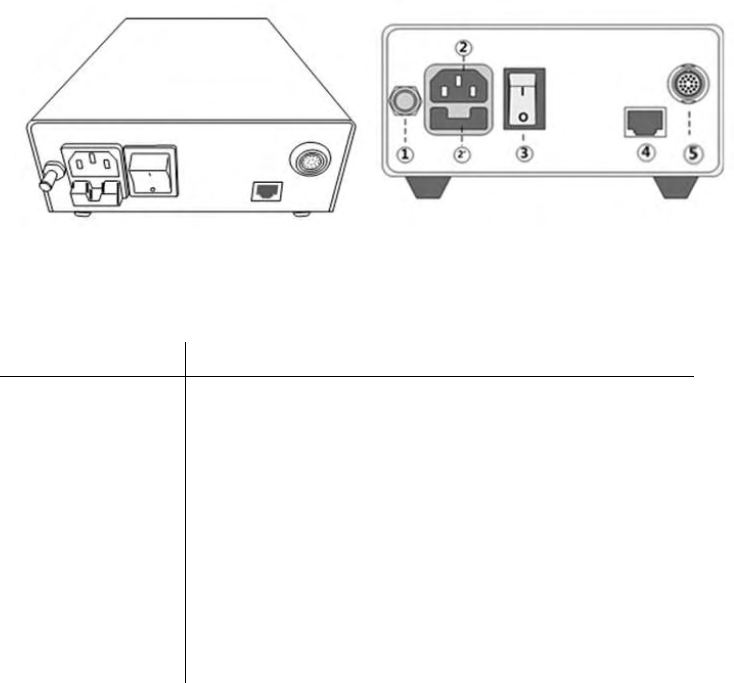
27
Power Supply Box
F
IGURE
10 P
OWER
S
UPPLY
B
OX
Table 5 P
OWER
S
UPPLY
B
OX
D
ESCRIPTION
Item
Description
Power Supply Box
①
Grounding Jack : Common Ground or Earth
②
AC Inlet: AC Power Plug (2' - Fuse socket)
Input AC Socket Type : IEC60320 C14 Type
Input AC Socket : 6220(SCHURTER)
③
Power switch: Power On/Off switch
→ Green colored indicator is constant when Power ON
④
LAN port : LAN cable connector
⑤
Main Cable Connector : connecting power supply with detector
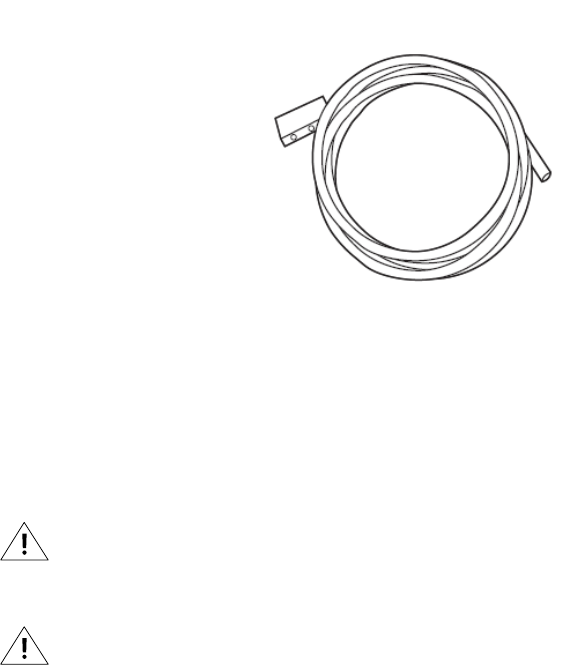
28
Main Cable
FIGURE 11 MAIN CABLE
This cable connects the detector to the power supply box.
Because the instrument’s cable is long, take care so cables do not get tangled during use.
Also, be careful not to get your feet caught in the cable.
Do not pull the cable by force. And If the cable gets tangled, do not pull the main body of portable
detector by force. Otherwise, the cable is damaged and causes fire or electric shock.
WARNING
WARNING
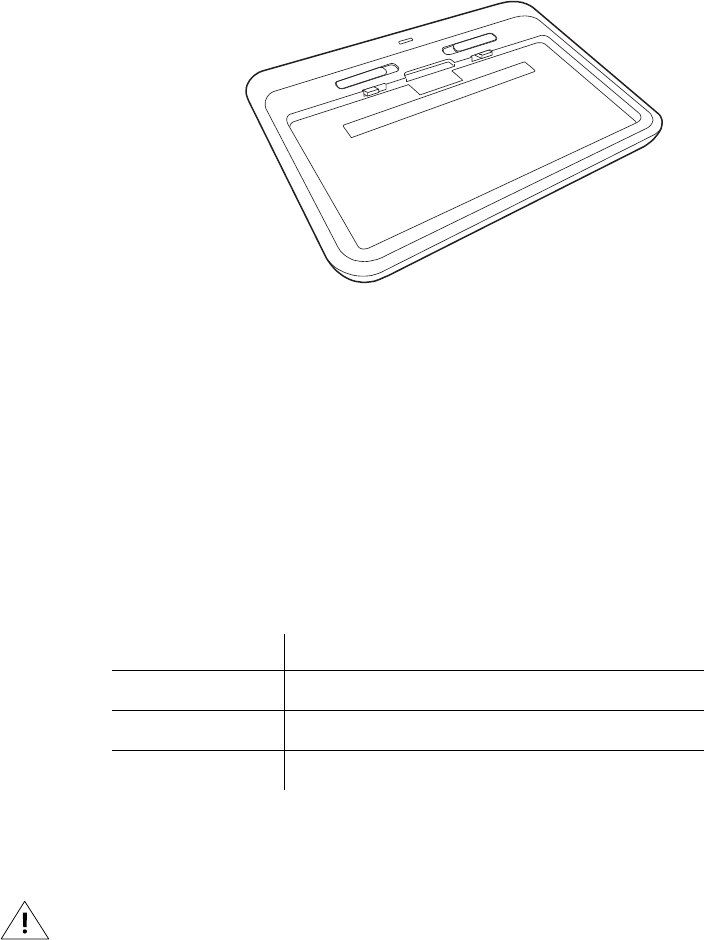
29
Battery Recharger
The battery recharger is used for S3025-W. You can recharge the battery and check the charge
condition.
FIGURE 12 BATTERY RECHARGER
1. LED: Indicates the condition of charge. This is turned off when the power is disconnected or is not
recharged.
2. The Battery recharger Terminal
3. Knob: It is used to detach a battery from the recharger.
Indicates as follows When the battery recharges, When the battery is recharging, it changes red into
green according to the level of charge.
LED
The status of batt
ery Recharger
•
Red
•
Fast charging mode ( Until About 90% )
•
Green
•
Normal charging mode ( About 85% ~ 100 % )
•
Blue
•
The error of charging
Table 6 BATTERY RECHARGER INDICATE LED
If LED light is blue during recharging the battery, stop recharging the battery immediately and check
whether there are Impurities or not in the battery recharger Terminal (②).
Despite taking action on upper step, if LED light is still blue, stop recharging the battery.
WARNING
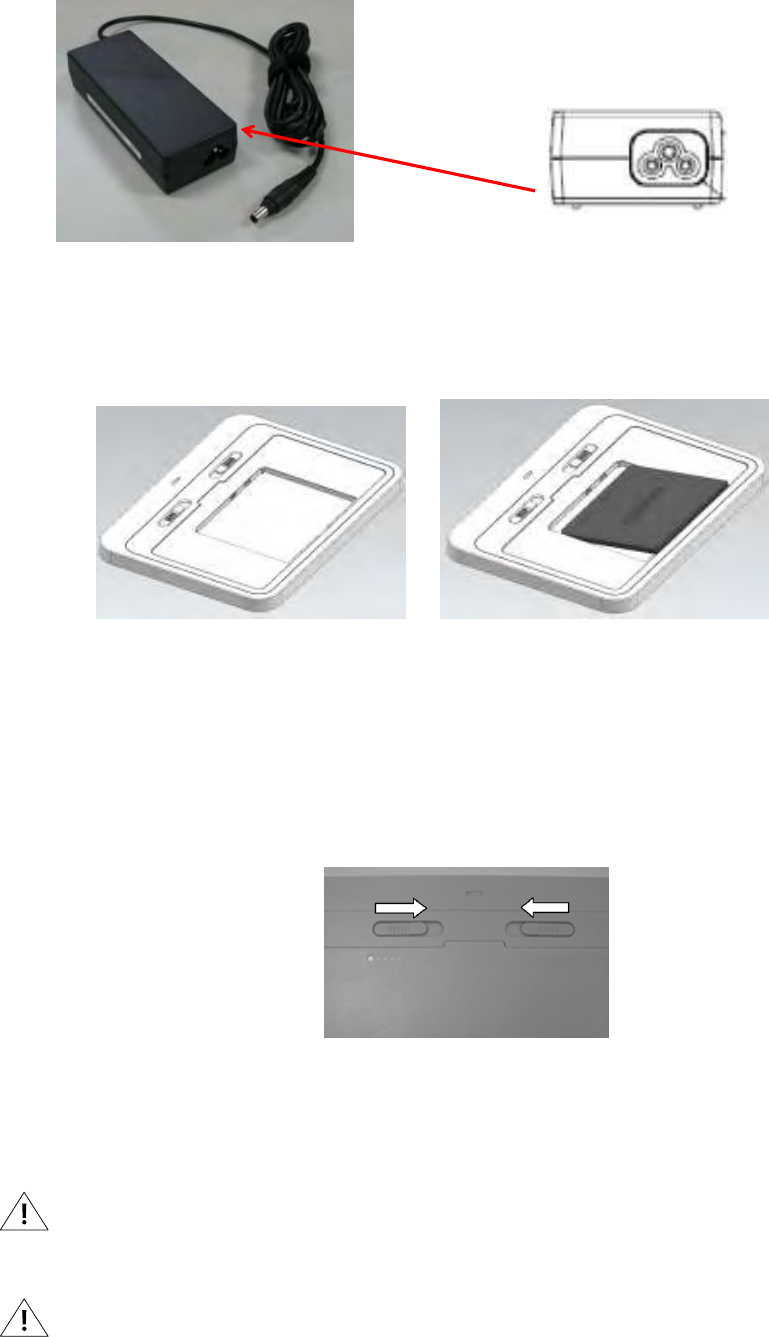
30
Recharger Adapter
Input AC Socket Type : IEC 320 C6 Type.
The use
FIGURE 13 BATTERY INSERT
After the Adaptor (AD-9019S) connects to Power cord, be sure to connect it to Adaptor terminal on the
back side of Recharger
Be sure to insert the battery to recharger until it sounds clack.
FIGURE 14 BATTERY LOCK
Be sure to push inside two knobs to the end when the battery detached from the recharger.
• When using the S3025-W battery recharger, always use the battery (SDB-3S1PA) provided by
Samsung Electronics Co. Ltd..
• When using Battery recharger, Be sure to use Adapter (AD-9019S) Provided by Samsung Electronics Co. Ltd..
• When moving the S3025-W battery recharger, always separate the power and battery pack
WARNING
WARNING

31
• When using the S3025-W battery recharger, Always be cautious about touching liquid, impurities.
In case of short trouble.
• Do not disassemble the battery recharger.
• When using the S3025-W battery recharger, be sure to comply with the user environment. The
performance of S3025-W battery can be down and the durability can be shorter.
• Be sure to use the S3025-W battery recharger in the Control Room. This battery recharger is not
designed to use in the Examination Room.
• When not using the S3025-W battery recharger for a long time. Always do separate the battery
recharger from the Power.
• When inserting the battery to the battery recharger, Be careful of being caught clothes or
impurities.
WARNING
WARNING
WARNING
WARNING
WARNING
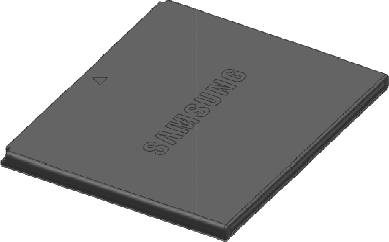
Battery
This is the battery for using the
F
IGURE
This is the battery for using the
S3025-W
(Detector) by wireless communications
32
IGURE
15 BATTERY
(Detector) by wireless communications

33
• Be sure to recharge the battery by using the S3025-W (Detector) or the battery recharger (DEPS-9606) provided by
Samsung Electronics Co. Ltd..
• If the battery is needed to be stored for a long period, battery should be removed from the application and stored in a
place where humidity and temperature are low.
• While the battery is charged, used and stored, keep it away from object materials with static electric chargers.
• If the terminals of the battery become dirty, wipe with a dry cloth before using the battery.
• Be sure to use the battery in the environment designated by Samsung. Otherwise, the life of battery can be short
• Stop using the battery if the battery becomes abnormally hot, disorder, discoloration, deformation, or abnormal
conditions is detected during use, charge, or storage.
Don't short circuit (+) and (-) terminals with metallic object intentionally.
• Not be sure to touch liquid on the surface of the battery.
Don't pierce the battery with a sharp object such as a needle, screw drivers.
• Do not hit the battery with heavy objects.
• Don't step on the battery and throw or drop the battery on the hard floor to avoid mechanical shock.
• Don't disassemble the battery or modify the battery design including electric circuit.
WARNING
WARNING
WARNING
WARNING
WARNING
WARNING
WARNING
WARNING
WARNING
WARNING
WARNING
WARNING
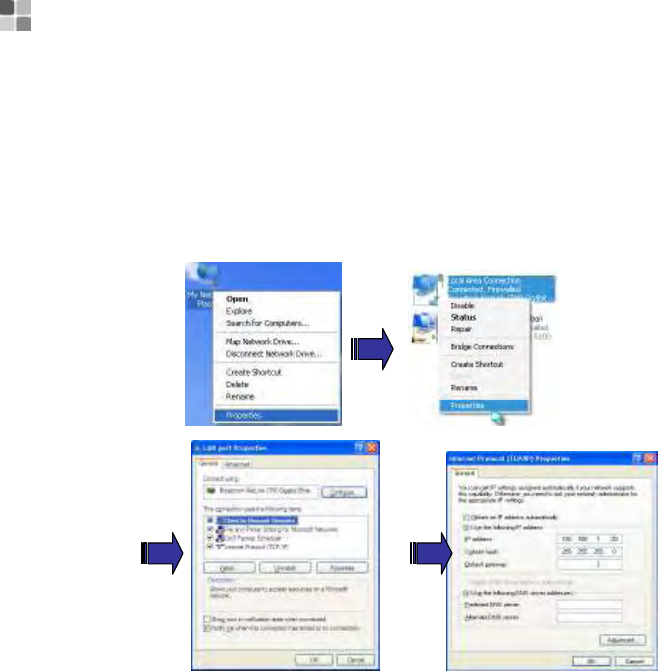
34
4.
O
PERATING THE
S
YSTEM
H
ARDWARE
Operating the System Hardware
IP set up
[My Network Places] → [Properties] → [Local Area Connection] → [Properties] → [Internet Protocol
(TCP/IP)]
→ [Use the following IP address]
IP address : 192 . 168 . 197 . 20 (Console PC)
Detector IP address is 192. 168. 197. 80 (default)
Figure 16 IP SET UP
It is possible to change IP address, but it shouldn’t be the same as the detector IP address.
Checking Connection
Check LED on the detector & power supply
Ping test: [Start] → [Run] → ping -t 192.168.197.80
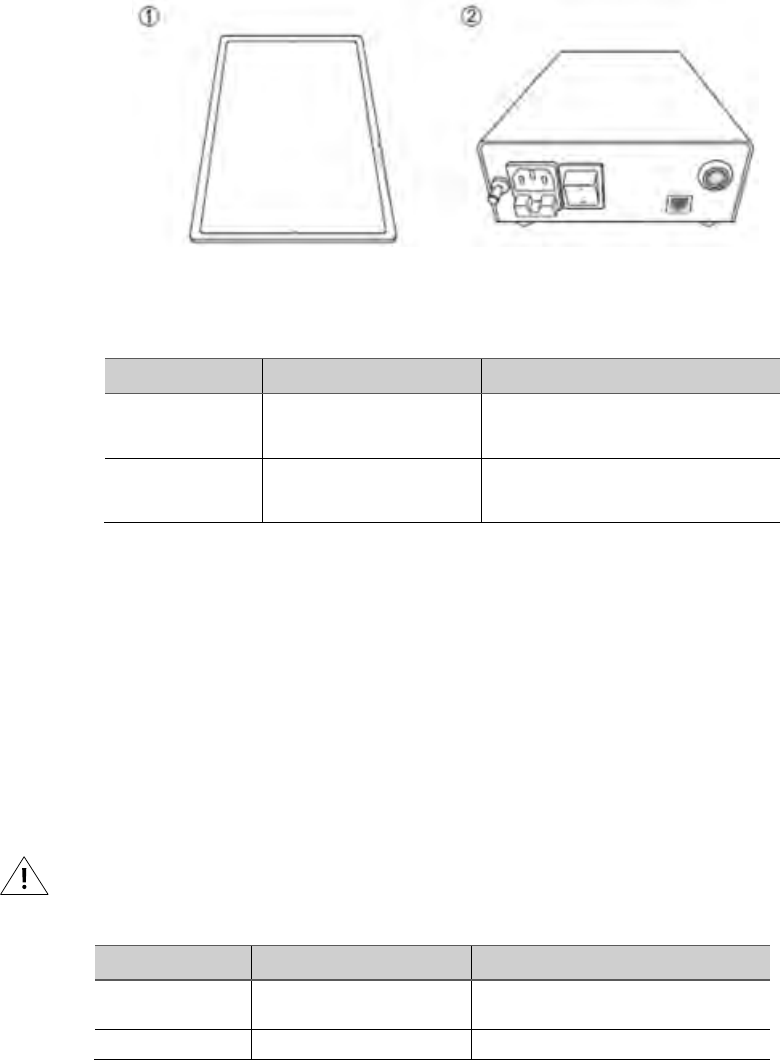
35
Operation
Switching power on / off
This equipment is turned on by the Power Button of each component.
Table 9 lists the methods for checking the power on status of the system components.
FIGURE 17 POWER APPLIED COMPONENTS (S3025-W)
Table 7
CHECKING THE POWER STATUS OF COMPONENTS (S3025-W)
All connection should be done, before turn on the power supply box.
Turn on the power of the detector power supply box, workstation.
The green light of the LED indicator on the detector is on, the detector power is on.
The blue light of the LED indicator on the detector is blinking, the detector is getting prepared to work
and initialize.
Turn off the power of the detector power supply box
When Detector is not turned on, be sure to check the Connection, the status of Battery and installation at first.
Below table 10 for turning off each component.
Table 8
POWER OFF STATUS
Component
Power
button location
To check the power status
Detector
Power switch on the bottom of
the right side
Dimming blue power LED
Power supply Box
The front side of Power supply
box
Green power LED
Component
Power Button Location
To check the power status
Detector
On the bottom of the right side
White power LED is turned off.
Power supply
The front side
of PSU
Green power LED is turned off.
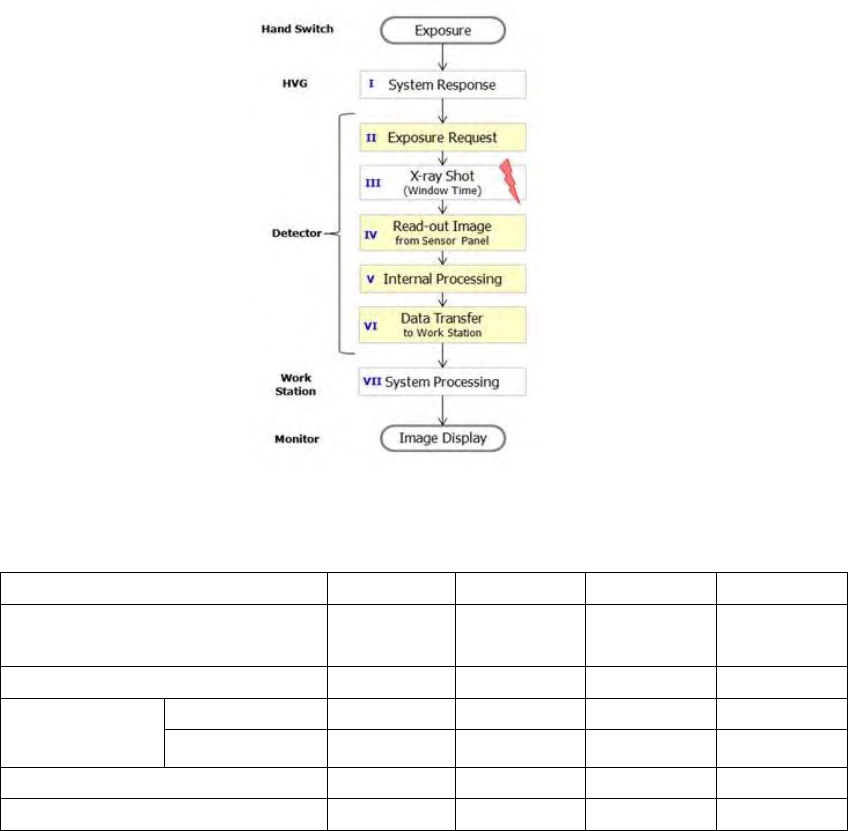
36
Operating description
Figure 18:
TIMING CHART
Item min. typ. max. unit
Exposure request time (II)
Before x-ray pulse start - - 0.5 sec
Exposure window - 0.5 4.0 sec
Image transmitted
after exposure done
(IV + V + VI)
Wireless 3.5 4.0 - sec
Wired - 2.05 2.50 sec
Image cycle time for exposure of 0.5sec
8
-
-
sec
Booting time - 34 40 sec
Table 9
OPERATING TIME TABLE
37
5.
A
PPENDICES
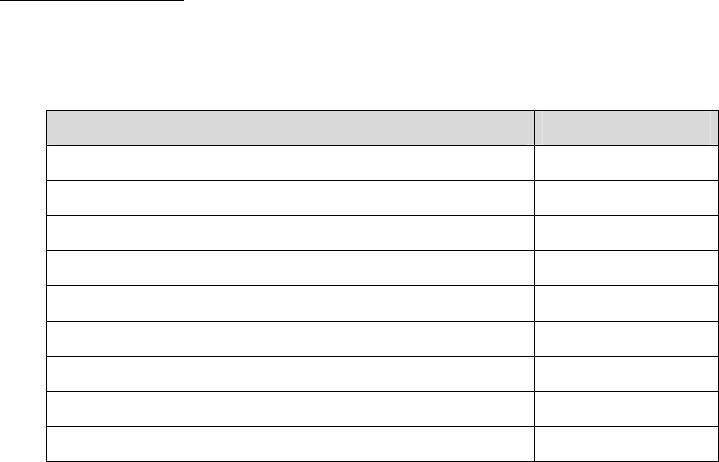
38
REQUIRED PUBLIC STATEMENT FOR GPL/LGPL/GPLv2/OpenSSL/CPOL
LICENSED SOFTWARE USED IN THIS PRODUCT
The software included in this product contains copyrighted software that is licensed under the GPL/LGPL. You may obtain the complete Corresponding
Source code from us for a period of three years after our last shipment of this product by sending email to:
oss.request@samsung.com
This offer is valid to anyone in receipt of this information.
Source/Lib
License
Kernel 3.2.0 GPLv2
U
-
boot 2011.09
GPLv2
Busybox 1.19.4 GPLv2
Mtd
-
util
-
1.5.0
GPLv2
Glib 2.12.2
LGPL v2.1
Hostap
BSD
Libnl
-
1
LGPL v2.1
Iw
-
3.0
-
Wi
-
fi driver(atheros AR1021x)
GPLv2
39
GNU GENERAL PUBLIC LICENSE
Version 2, June 1991
Copyright (C) 1989, 1991 Free Software Foundation, Inc.,
51 Franklin Street, Fifth Floor, Boston, MA 02110-1301 USA
Everyone is permitted to copy and distribute verbatim copies of this license document, but changing it is not allowed.
Preamble
The licenses for most software are designed to take away your freedom to share and change it. By contrast, the GNU General Public License is intended to
guarantee your freedom to share and change free software--to make sure the software is free for all its users. This General Public License applies to most of
the Free Software Foundation's software and to any other program whose authors commit to using it. (Some other Free Software Foundation software is
covered by the GNU Lesser General Public License instead.) You can apply it to your programs, too.
When we speak of free software, we are referring to freedom, not price. Our General Public Licenses are designed to make sure that you have the
freedom to distribute copies of free software (and charge for this service if you wish), that you receive source code or can get it if you want it, that you can
change the software or use pieces of it in new free programs; and that you know you can do these things.
To protect your rights, we need to make restrictions that forbid anyone to deny you these rights or to ask you to surrender the rights. These restrictions
translate to certain responsibilities for you if you distribute copies of the software, or if you modify it.
For example , if you distribute copies of such a program, whether gratis or for a fee, you must give the recipients all the rights that you have. You must
make sure that they, too, receive or can get the source code. And you must show them these terms so they know their rights.
We protect your rights with two steps: (1) copyright the software, and (2) offer you this license which gives you legal permission to copy, distribute and/or
modify the software.
Also, for each author's protection and ours, we want to make certain that everyone understands that there is no warranty for this free software. If the
software is modified by someone else and passed on, we want its recipients to know that what they have is not the original, so that any problems introduced
by others will not reflect on the original authors' reputations.
Finally, any free program is threatened constantly by software patents. We wish to avoid the danger that redistributors of a free program will individually
obtain patent licenses, in effect making the program proprietary. To prevent this, we have made it clear that any patent must be licensed for everyone's
free use or not licensed at all.
The precise terms and conditions for copying, distribution and modification follow.
GNU GENERAL PUBLIC LICENSE
TERMS AND CONDITIONS FOR COPYING, DISTRIBUTION AND MODIFICATION
0. This License applies to any program or other work which contains a notice placed by the copyright holder saying it may be distributed under the terms of
this General Public License. The "Program", below, refers to any such program or work, and a "work based on the Program" means either the Program or
any derivative work under copyright law: that is to say, a work containing the Program or a portion of it, either verbatim or with modifications and/or
translated into another language. (Hereinafter, translation is included without limitation in the term "modification".) Each licensee is addressed as "you".
Activities other than copying, distribution and modification are not covered by this License; they are outside its scope. The act of running the Program is not
restricted, and the output from the Program is covered only if its contents constitute a work based on the Program (independent of having been made by
running the Program). Whether that is true depends on what the Program does.
40
1. You may copy and distribute verbatim copies of the Program's source code as you receive it, in any medium, provided that you conspicuously and
appropriately publish on each copy an appropriate copyright notice and disclaimer of warranty; keep intact all the notices that refer to this License and to the
absence of any warranty; and give any other recipients of the Program a copy of this License along with the Program.
You may charge a fee for the physical act of transferring a copy, and you may at your option offer warranty protection in exchange for a fee.
2. You may modify your copy or copies of the Program or any portion of it, thus forming a work based on the Program, and copy and distribute such
modifications or work under the terms of Section 1 above, provided that you also meet all of these conditions:
a) You must cause the modified files to carry prominent notices stating that you changed the files and the date of any change.
b) You must cause any work that you distribute or publish, that in whole or in part contains or is derived from the Program or any part thereof, to be
licensed as a whole at no charge to all third parties under the terms of this License.
c) If the modified program normally reads commands interactively when run, you must cause it, when started running for such interactive use in the most
ordinary way, to print or display an
Announcement including an appropriate copyright notice and a notice that there is no warranty (or else, saying that you provide a warranty) and that
users may redistribute the program under these conditions, and telling the user how to view a copy of this License. (Exception: if the Program itself is
interactive but does not normally print such an announcement, your work based on the Program is not required to print an announcement.)
These requirements apply to the modified work as a whole. If identifiable sections of that work are not derived from the Program, and can be reasonably
considered independent and separate works in themselves, then this License, and its terms, do not apply to those sections when you distribute them as
separate works. But when you distribute the same sections as part of a whole which is a work based on the Program, the distribution of the whole must be
on the terms of this License, whose permissions for other licensees extend to the entire whole, and thus to each and every part regardless of who wrote it.
Thus, it is not the intent of this section to claim rights or contest your rights to work written entirely by you; rather, the intent is to exercise the right to
control the distribution of derivative or
Collective works based on the Program.
In addition, mere aggregation of another work not based on the Program with the Program (or with a work based on the Program) on a volume of a storage
or distribution medium does not bring the other work under the scope of this License.
3. You may copy and distribute the Program (or a work based on it, under Section 2) in object code or executable form under the terms of Sections 1 and 2
above provided that you also do one of the following:
a) Accompany it with the complete corresponding machine-readable source code, which must be distributed under the terms of Sections 1 and 2 above on
a medium customarily used for software interchange; or,
b) Accompany it with a written offer, valid for at least three years, to give any third party, for a charge no more than your cost of physically performing
source distribution, a complete machine-readable copy of the corresponding source code, to be distributed under the terms of Sections 1 and 2 above on a
medium customarily used for software interchange; or,
c) Accompany it with the information you received as to the offer to distribute corresponding source code. (This alternative is allowed only for
noncommercial distribution and only if you received the program in object code or executable form with such an offer, in accord with Subsection b above.)
The source code for a work means the preferred form of the work for making modifications to it. For an executable work, complete source code means all
the source code for all modules it contains, plus any associated interface definition files, plus the scripts used to control compilation and installation of the
executable. However, as a special exception, the source code distributed need not include anything that is normally distributed (in either source or binary
form) with the major components (compiler, kernel, and so on) of the operating system on which the executable runs, unless that component itself
accompanies the executable.
41
If distribution of executable or object code is made by offering access to copy from a designated place, then offering equivalent access to copy the source
code from the same place counts as distribution of the source code, even though third parties are not compelled to copy the source along with the object
code.
4. You may not copy, modify, sublicense, or distribute the Program except as expressly provided under this License. Any attempt otherwise to copy,
modify, sublicense or distribute the Program is void, and will automatically terminate your rights under this License. However, parties who have received
copies, or rights, from you under this License will not have their licenses terminated so long as such parties remain in full compliance.
5. You are not required to accept this License, since you have not signed it. However, nothing else grants you permission to modify or distribute the
Program or its derivative works. These actions are prohibited by law if you do not accept this License. Therefore, by modifying or distributing the Program
(or any work based on the Program), you indicate your acceptance of this License to do so, and all its terms and conditions for copying, distributing or
modifying the Program or works based on it.
6. Each time you redistribute the Program (or any work based on the Program), the recipient automatically receives a license from the original licensor to
copy, distribute or modify the Program subject to these terms and conditions. You may not impose any further restrictions on the recipients' exercise of the
rights granted herein. You are not responsible for enforcing compliance by third parties to this License.
7. If, as a consequence of a court judgment or allegation of patent infringement or for any other reason (not limited to patent issues), conditions are
imposed on you (whether by court order, agreement or otherwise) that contradict the conditions of this License, they do not excuse you from the conditions
of this License. If you cannot distribute so as to satisfy simultaneously your obligations under this License and any other pertinent obligations, then as a
consequence you may not distribute the Program at all. For example, if a patent license would not permit royalty-free redistribution of the Program by all
those who receive copies directly or indirectly through you, then the only way you could satisfy both it and this License would be to refrain entirely from
distribution of the Program.
If any portion of this section is held invalid or unenforceable under any particular circumstance, the balance of the section is intended to apply and the
section as a whole is intended to apply in other circumstances.
It is not the purpose of this section to induce you to infringe any patents or other property right claims or to contest validity of any such claims; this section
has the sole purpose of protecting the integrity of the free software distribution system, which is implemented by public license practices. Many people have
made generous contributions to the wide range of software distributed through that system in reliance on consistent application of that system; it is up to
the author/donor to decide if he or she is willing to distribute software through any other system and a licensee cannot impose that choice.
This section is intended to make thoroughly clear what is believed to be a consequence of the rest of this License.
8. If the distribution and/or use of the Program is restricted in certain countries either by patents or by copyrighted interfaces, the original copyright holder
who places the Program under this License may add an explicit geographical distribution limitation excluding those countries, so that distribution is permitted
only in or among countries not thus excluded. In such case, this License incorporates the limitation as if written in the body of this License.
9. The Free Software Foundation may publish revised and/or new versions of the General Public License from time to time. Such new versions will be
similar in spirit to the present version, but may differ in detail to address new problems or concerns.
Each version is given a distinguishing version number. If the Program specifies a version number of this License which applies to it and "any later version",
you have the option of following the terms and conditions either of that version or of any later version published by the Free Software Foundation. If the
Program does not specify a version number of this License, you may choose any version ever published by the Free Software Foundation.
10. If you wish to incorporate parts of the Program into other free programs whose distribution conditions are different, write to the author to ask for
permission. For software which is copyrighted by the Free Software Foundation, write to the Free Software Foundation; we sometimes make exceptions for
this. Our decision will be guided by the two goals of preserving the free status of all derivatives of our free software and of promoting the sharing and reuse
of software generally.
NO WARRANTY
42
11. BECAUSE THE PROGRAM IS LICENSED FREE OF CHARGE, THERE IS NO WARRANTY FOR THE PROGRAM, TO THE EXTENT PERMITTED BY APPLICABLE
LAW. EXCEPT WHEN OTHERWISE STATED IN WRITING THE COPYRIGHT HOLDERS AND/OR OTHER PARTIES PROVIDE THE PROGRAM "AS IS" WITHOUT
WARRANTY OF ANY KIND, EITHER EXPRESSED OR IMPLIED, INCLUDING, BUT NOT LIMITED TO, THE IMPLIED WARRANTIES OF MERCHANTABILITY AND
FITNESS FOR A PARTICULAR PURPOSE. THE ENTIRE RISK AS TO THE QUALITY AND PERFORMANCE OF THE PROGRAM IS WITH YOU. SHOULD THE
PROGRAM PROVE DEFECTIVE, YOU ASSUME THE COST OF ALL NECESSARY SERVICING, REPAIR OR CORRECTION.
12. IN NO EVENT UNLESS REQUIRED BY APPLICABLE LAW OR AGREED TO IN WRITING WILL ANY COPYRIGHT HOLDER, OR ANY OTHER PARTY WHO
MAY MODIFY AND/OR REDISTRIBUTE THE PROGRAM AS PERMITTED ABOVE, BE LIABLE TO YOU FOR DAMAGES, INCLUDING ANY GENERAL, SPECIAL,
INCIDENTAL OR CONSEQUENTIAL DAMAGES ARISING OUT OF THE USE OR INABILITY TO USE THE PROGRAM (INCLUDING BUT NOT LIMITED TO LOSS
OF DATA OR DATA BEING RENDERED INACCURATE OR LOSSES SUSTAINED BY YOU OR THIRD PARTIES OR A FAILURE OF THE PROGRAM TO OPERATE
WITH ANY OTHER PROGRAMS), EVEN IF SUCH HOLDER OR OTHER PARTY HAS BEEN ADVISED OF THE POSSIBILITY OF SUCH DAMAGES.
END OF TERMS AND CONDITIONS
How to Apply These Terms to Your New Programs
If you develop a new program, and you want it to be of the greatest possible use to the public, the best way to achieve this is to make it free software
which everyone can redistribute and change under these terms.
To do so, attach the following notices to the program. It is safest to attach them to the start of each source file to most effectively convey the exclusion of
warranty; and each file should have at least the "copyright" line and a pointer to where the full notice is found.
<one line to give the program's name and a brief idea of what it does.>
Copyright (C) <year> <name of author>
This program is free software; you can redistribute it and/or modify
it under the terms of the GNU General Public License as published by
the Free Software Foundation; either version 2 of the License, or
(at your option) any later version.
This program is distributed in the hope that it will be useful,
but WITHOUT ANY WARRANTY; without even the implied warranty of
MERCHANTABILITY or FITNESS FOR A PARTICULAR PURPOSE. See the
GNU General Public License for more details.
You should have received a copy of the GNU General Public License along
with this program; if not, write to the Free Software Foundation, Inc.,
51 Franklin Street, Fifth Floor, Boston, MA 02110-1301 USA.
Also add information on how to contact you by electronic and paper mail.
If the program is interactive, make it output a short notice like this when it starts in an interactive mode:
Gnomovision version 69, Copyright (C) year name of author
Gnomovision comes with ABSOLUTELY NO WARRANTY; for details type `show w'.
This is free software, and you are welcome to redistribute it
under certain conditions; type `show c' for details.
43
The hypothetical commands `show w' and `show c' should show the appropriate parts of the General Public License. Of course, the commands you use may
be called something other than `show w' and `show c'; they could even be mouse-clicks or menu items--whatever suits your program.
You should also get your employer (if you work as a programmer) or your school, if any, to sign a "copyright disclaimer" for the program, if necessary. Here
is a sample; alter the names:
Yoyodyne, Inc., hereby disclaims all copyright interest in the program
`Gnomovision' (which makes passes at compilers) written by James Hacker.
<signature of Ty Coon>, 1 April 1989
Ty Coon, President of Vice
This General Public License does not permit incorporating your program into proprietary programs. If your program is a subroutine library, you may consider
it more useful to permit linking proprietary applications with the library. If this is what you want to do, use the GNU Lesser General Public License instead of
this License.
44
GNU LESSER GENERAL PUBLIC LICENSE
Version 2.1, February 1999
Copyright (C) 1991, 1999 Free Software Foundation, Inc.
51 Franklin Street, Fifth Floor, Boston, MA 02110-1301 USA
Everyone is permitted to copy and distribute verbatim copies of this license document, but changing it is not allowed.
[This is the first released version of the Lesser GPL. It also counts as the successor of the GNU Library Public License, version 2, hence the version number
2.1.]
Preamble
The licenses for most software are designed to take away your freedom to share and change it. By contrast, the GNU General Public Licenses are intended to
guarantee your freedom to share and change free software--to make sure the software is free for all its users.
This license, the Lesser General Public License, applies to some specially designated software packages--typically libraries--of the Free Software Foundation
and other authors who decide to use it. You can use it too, but we suggest you first think carefully about whether this license or the ordinary General Public
License is the better strategy to use in any particular case, based on the explanations below.
When we speak of free software, we are referring to freedom of use, not price. Our General Public Licenses are designed to make sure that you have the
freedom to distribute copies of free software (and charge for this service if you wish); that you receive source code or can get it if you want it; that you can
change the software and use pieces of it in new free programs; and that you are informed that you can do these things.
To protect your rights, we need to make restrictions that forbid distributors to deny you these rights or to ask you to surrender these rights. These
restrictions translate to certain responsibilities for you if you distribute copies of the library or if you modify it.
For example, if you distribute copies of the library, whether gratis or for a fee, you must give the recipients all the rights that we gave you. You must make
sure that they, too, receive or can get the source code. If you link other code with the library, you must provide complete object files to the recipients, so
that they can relink them with the library after making changes to the library and recompiling it. And you must show them these terms so they know their
rights.
We protect your rights with a two-step method: (1) we copyright the library, and (2) we offer you this license, which gives you legal permission to copy,
distribute and/or modify the library.
To protect each distributor, we want to make it very clear that there is no warranty for the free library. Also, if the library is modified by someone else and
passed on, the recipients should know that what they have is not the original version, so that the original author's reputation will not be affected by
problems that might be introduced by others.
Finally, software patents pose a constant threat to the existence of any free program. We wish to make sure that a company cannot effectively restrict the
users of a free program by obtaining a restrictive license from a patent holder. Therefore, we insist that any patent license obtained for a version of the
library must be consistent with the full freedom of use specified in this license.
Most GNU software, including some libraries, is covered by the ordinary GNU General Public License. This license, the GNU Lesser General Public License,
applies to certain designated libraries, and is quite different from the ordinary General Public License. We use this license for certain libraries in order to
permit linking those libraries into non-free programs.
When a program is linked with a library, whether statically or using a shared library, the combination of the two is legally speaking a combined work, a
derivative of the original library. The ordinary General Public License therefore permits such linking only if the entire combination fits its criteria of freedom.
The Lesser General Public License permits more lax criteria for linking other code with the library.
We call this license the "Lesser" General Public License because it does Less to protect the user's freedom than the ordinary General Public License. It also
provides other free software developers Less of an advantage over competing non-free programs. These disadvantages are the reason we use the ordinary
General Public License for many libraries. However, the Lesser license provides advantages in certain special circumstances.
For example, on rare occasions, there may be a special need to encourage the widest possible use of a certain library, so that it becomes a de-facto
standard. To achieve this, non-free programs must be allowed to use the library. A more frequent case is that a free library does the same job as widely
used non-free libraries. In this case, there is little to gain by limiting the free library to free software only, so we use the Lesser General Public License.
In other cases, permission to use a particular library in non-free programs enables a greater number of people to use a large body of free software. For
example, permission to use the GNU C Library in non-free programs enables many more people to use the whole GNU operating system, as well as its
variant, the GNU/Linux operating system.
45
Although the Lesser General Public License is Less protective of the users' freedom, it does ensure that the user of a program that is linked with the Library
has the freedom and the wherewithal to run that program using a modified version of the Library.
The precise terms and conditions for copying, distribution and modification follow. Pay close attention to the difference between a "work based on the
library" and a "work that uses the library". The former contains code derived from the library, whereas the latter must be combined with the library in order
to run.
TERMS AND CONDITIONS FOR COPYING, DISTRIBUTION AND MODIFICATION
0. This License Agreement applies to any software library or other program which contains a notice placed by the copyright holder or other authorized party
saying it may be distributed under the terms of this Lesser General Public License (also called "this License"). Each licensee is addressed as "you".
A "library" means a collection of software functions and/or data prepared so as to be conveniently linked with application programs (which use some of those
functions and data) to form executables.
The "Library", below, refers to any such software library or work which has been distributed under these terms. A "work based on the Library" means either
the Library or any derivative work under copyright law: that is to say, a work containing the Library or a portion of it, either verbatim or with modifications
and/or translated straightforwardly into another language. (Hereinafter, translation is included without limitation in the term "modification".)
"Source code" for a work means the preferred form of the work for making modifications to it. For a library, complete source code means all the source code
for all modules it contains, plus any associated interface definition files, plus the scripts used to control compilation and installation of the library.
Activities other than copying, distribution and modification are not covered by this License; they are outside its scope. The act of running a program using
the Library is not restricted, and output from such a program is covered only if its contents constitute a work based on the Library (independent of the use of
the Library in a tool for writing it). Whether that is true depends on what the Library does and what the program that uses the Library does.
1. You may copy and distribute verbatim copies of the Library's complete source code as you receive it, in any medium, provided that you conspicuously and
appropriately publish on each copy an appropriate copyright notice and disclaimer of warranty; keep intact all the notices that refer to this License and to the
absence of any warranty; and distribute a copy of this License along with the Library.
You may charge a fee for the physical act of transferring a copy, and you may at your option offer warranty protection in exchange for a fee.
2. You may modify your copy or copies of the Library or any portion of it, thus forming a work based on the Library, and copy and distribute such
modifications or work under the terms of Section 1 above, provided that you also meet all of these conditions:
• a) The modified work must itself be a software library.
• b) You must cause the files modified to carry prominent notices stating that you changed the files and the date of any change.
• c) You must cause the whole of the work to be licensed at no charge to all third parties under the terms of this License.
• d) If a facility in the modified Library refers to a function or a table of data to be supplied by an application program that uses the facility, other than
as an argument passed when the facility is invoked, then you must make a good faith effort to ensure that, in the event an application does not
supply such function or table, the facility still operates, and performs whatever part of its purpose remains meaningful.
(For example, a function in a library to compute square roots has a purpose that is entirely well-defined independent of the application. Therefore,
Subsection 2d requires that any application-supplied function or table used by this function must be optional: if the application does not supply it,
the square root function must still compute square roots.)
These requirements apply to the modified work as a whole. If identifiable sections of that work are not derived from the Library, and can be reasonably
considered independent and separate works in themselves, then this License, and its terms, do not apply to those sections when you distribute them as
separate works. But when you distribute the same sections as part of a whole which is a work based on the Library, the distribution of the whole must be on
the terms of this License, whose permissions for other licensees extend to the entire whole, and thus to each and every part regardless of who wrote it.
Thus, it is not the intent of this section to claim rights or contest your rights to work written entirely by you; rather, the intent is to exercise the right to
control the distribution of derivative or collective works based on the Library.
In addition, mere aggregation of another work not based on the Library with the Library (or with a work based on the Library) on a volume of a storage or
distribution medium does not bring the other work under the scope of this License.
3. You may opt to apply the terms of the ordinary GNU General Public License instead of this License to a given copy of the Library. To do this, you must
alter all the notices that refer to this License, so that they refer to the ordinary GNU General Public License, version 2, instead of to this License. (If a newer
version than version 2 of the ordinary GNU General Public License has appeared, then you can specify that version instead if you wish.) Do not make any
other change in these notices.
Once this change is made in a given copy, it is irreversible for that copy, so the ordinary GNU General Public License applies to all subsequent copies and
derivative works made from that copy.
This option is useful when you wish to copy part of the code of the Library into a program that is not a library.
46
4. You may copy and distribute the Library (or a portion or derivative of it, under Section 2) in object code or executable form under the terms of Sections 1
and 2 above provided that you accompany it with the complete corresponding machine-readable source code, which must be distributed under the terms of
Sections 1 and 2 above on a medium customarily used for software interchange.
If distribution of object code is made by offering access to copy from a designated place, then offering equivalent access to copy the source code from the
same place satisfies the requirement to distribute the source code, even though third parties are not compelled to copy the source along with the object
code.
5. A program that contains no derivative of any portion of the Library, but is designed to work with the Library by being compiled or linked with it, is called a
"work that uses the Library". Such a work, in isolation, is not a derivative work of the Library, and therefore falls outside the scope of this License.
However, linking a "work that uses the Library" with the Library creates an executable that is a derivative of the Library (because it contains portions of the
Library), rather than a "work that uses the library". The executable is therefore covered by this License. Section 6 states terms for distribution of such
executables.
When a "work that uses the Library" uses material from a header file that is part of the Library, the object code for the work may be a derivative work of the
Library even though the source code is not. Whether this is true is especially significant if the work can be linked without the Library, or if the work is itself a
library. The threshold for this to be true is not precisely defined by law.
If such an object file uses only numerical parameters, data structure layouts and accessors, and small macros and small inline functions (ten lines or less in
length), then the use of the object file is unrestricted, regardless of whether it is legally a derivative work. (Executables containing this object code plus
portions of the Library will still fall under Section 6.)
Otherwise, if the work is a derivative of the Library, you may distribute the object code for the work under the terms of Section 6. Any executables
containing that work also fall under Section 6, whether or not they are linked directly with the Library itself.
6. As an exception to the Sections above, you may also combine or link a "work that uses the Library" with the Library to produce a work containing portions
of the Library, and distribute that work under terms of your choice, provided that the terms permit modification of the work for the customer's own use and
reverse engineering for debugging such modifications.
You must give prominent notice with each copy of the work that the Library is used in it and that the Library and its use are covered by this License. You
must supply a copy of this License. If the work during execution displays copyright notices, you must include the copyright notice for the Library among
them, as well as a reference directing the user to the copy of this License. Also, you must do one of these things:
• a) Accompany the work with the complete corresponding machine-readable source code for the Library including whatever changes were used in
the work (which must be distributed under Sections 1 and 2 above); and, if the work is an executable linked with the Library, with the complete
machine-readable "work that uses the Library", as object code and/or source code, so that the user can modify the Library and then relink to
produce a modified executable containing the modified Library. (It is understood that the user who changes the contents of definitions files in the
Library will not necessarily be able to recompile the application to use the modified definitions.)
• b) Use a suitable shared library mechanism for linking with the Library. A suitable mechanism is one that (1) uses at run time a copy of the library
already present on the user's computer system, rather than copying library functions into the executable, and (2) will operate properly with a
modified version of the library, if the user installs one, as long as the modified version is interface-compatible with the version that the work was
made with.
• c) Accompany the work with a written offer, valid for at least three years, to give the same user the materials specified in Subsection 6a, above, for
a charge no more than the cost of performing this distribution.
• d) If distribution of the work is made by offering access to copy from a designated place, offer equivalent access to copy the above specified
materials from the same place.
• e) Verify that the user has already received a copy of these materials or that you have already sent this user a copy.
For an executable, the required form of the "work that uses the Library" must include any data and utility programs needed for reproducing the executable
from it. However, as a special exception, the materials to be distributed need not include anything that is normally distributed (in either source or binary
form) with the major components (compiler, kernel, and so on) of the operating system on which the executable runs, unless that component itself
accompanies the executable.
It may happen that this requirement contradicts the license restrictions of other proprietary libraries that do not normally accompany the operating system.
Such a contradiction means you cannot use both them and the Library together in an executable that you distribute.
7. You may place library facilities that are a work based on the Library side-by-side in a single library together with other library facilities not covered by this
License, and distribute such a combined library, provided that the separate distribution of the work based on the Library and of the other library facilities is
otherwise permitted, and provided that you do these two things:
• a) Accompany the combined library with a copy of the same work based on the Library, uncombined with any other library facilities. This must be
distributed under the terms of the Sections above.
• b) Give prominent notice with the combined library of the fact that part of it is a work based on the Library, and explaining where to find the
accompanying uncombined form of the same work.
8. You may not copy, modify, sublicense, link with, or distribute the Library except as expressly provided under this License. Any attempt otherwise to copy,
modify, sublicense, link with, or distribute the Library is void, and will automatically terminate your rights under this License. However, parties who have
received copies, or rights, from you under this License will not have their licenses terminated so long as such parties remain in full compliance.
47
9. You are not required to accept this License, since you have not signed it. However, nothing else grants you permission to modify or distribute the Library
or its derivative works. These actions are prohibited by law if you do not accept this License. Therefore, by modifying or distributing the Library (or any work
based on the Library), you indicate your acceptance of this License to do so, and all its terms and conditions for copying, distributing or modifying the Library
or works based on it.
10. Each time you redistribute the Library (or any work based on the Library), the recipient automatically receives a license from the original licensor to
copy, distribute, link with or modify the Library subject to these terms and conditions. You may not impose any further restrictions on the recipients' exercise
of the rights granted herein. You are not responsible for enforcing compliance by third parties with this License.
11. If, as a consequence of a court judgment or allegation of patent infringement or for any other reason (not limited to patent issues), conditions are
imposed on you (whether by court order, agreement or otherwise) that contradict the conditions of this License, they do not excuse you from the conditions
of this License. If you cannot distribute so as to satisfy simultaneously your obligations under this License and any other pertinent obligations, then as a
consequence you may not distribute the Library at all. For example, if a patent license would not permit royalty-free redistribution of the Library by all those
who receive copies directly or indirectly through you, then the only way you could satisfy both it and this License would be to refrain entirely from
distribution of the Library.
If any portion of this section is held invalid or unenforceable under any particular circumstance, the balance of the section is intended to apply, and the
section as a whole is intended to apply in other circumstances.
It is not the purpose of this section to induce you to infringe any patents or other property right claims or to contest validity of any such claims; this section
has the sole purpose of protecting the integrity of the free software distribution system which is implemented by public license practices. Many people have
made generous contributions to the wide range of software distributed through that system in reliance on consistent application of that system; it is up to
the author/donor to decide if he or she is willing to distribute software through any other system and a licensee cannot impose that choice.
This section is intended to make thoroughly clear what is believed to be a consequence of the rest of this License.
12. If the distribution and/or use of the Library is restricted in certain countries either by patents or by copyrighted interfaces, the original copyright holder
who places the Library under this License may add an explicit geographical distribution limitation excluding those countries, so that distribution is permitted
only in or among countries not thus excluded. In such case, this License incorporates the limitation as if written in the body of this License.
13. The Free Software Foundation may publish revised and/or new versions of the Lesser General Public License from time to time. Such new versions will
be similar in spirit to the present version, but may differ in detail to address new problems or concerns.
Each version is given a distinguishing version number. If the Library specifies a version number of this License which applies to it and "any later version", you
have the option of following the terms and conditions either of that version or of any later version published by the Free Software Foundation. If the Library
does not specify a license version number, you may choose any version ever published by the Free Software Foundation.
14. If you wish to incorporate parts of the Library into other free programs whose distribution conditions are incompatible with these, write to the author to
ask for permission. For software which is copyrighted by the Free Software Foundation, write to the Free Software Foundation; we sometimes make
exceptions for this. Our decision will be guided by the two goals of preserving the free status of all derivatives of our free software and of promoting the
sharing and reuse of software generally.
NO WARRANTY
15. BECAUSE THE LIBRARY IS LICENSED FREE OF CHARGE, THERE IS NO WARRANTY FOR THE LIBRARY, TO THE EXTENT PERMITTED BY APPLICABLE
LAW. EXCEPT WHEN OTHERWISE STATED IN WRITING THE COPYRIGHT HOLDERS AND/OR OTHER PARTIES PROVIDE THE LIBRARY "AS IS" WITHOUT
WARRANTY OF ANY KIND, EITHER EXPRESSED OR IMPLIED, INCLUDING, BUT NOT LIMITED TO, THE IMPLIED WARRANTIES OF MERCHANTABILITY AND
FITNESS FOR A PARTICULAR PURPOSE. THE ENTIRE RISK AS TO THE QUALITY AND PERFORMANCE OF THE LIBRARY IS WITH YOU. SHOULD THE
LIBRARY PROVE DEFECTIVE, YOU ASSUME THE COST OF ALL NECESSARY SERVICING, REPAIR OR CORRECTION.
16. IN NO EVENT UNLESS REQUIRED BY APPLICABLE LAW OR AGREED TO IN WRITING WILL ANY COPYRIGHT HOLDER, OR ANY OTHER PARTY WHO MAY
MODIFY AND/OR REDISTRIBUTE THE LIBRARY AS PERMITTED ABOVE, BE LIABLE TO YOU FOR DAMAGES, INCLUDING ANY GENERAL, SPECIAL,
INCIDENTAL OR CONSEQUENTIAL DAMAGES ARISING OUT OF THE USE OR INABILITY TO USE THE LIBRARY (INCLUDING BUT NOT LIMITED TO LOSS OF
DATA OR DATA BEING RENDERED INACCURATE OR LOSSES SUSTAINED BY YOU OR THIRD PARTIES OR A FAILURE OF THE LIBRARY TO OPERATE WITH
ANY OTHER SOFTWARE), EVEN IF SUCH HOLDER OR OTHER PARTY HAS BEEN ADVISED OF THE POSSIBILITY OF SUCH DAMAGES.
END OF TERMS AND CONDITIONS
How to Apply These Terms to Your New Libraries
If you develop a new library, and you want it to be of the greatest possible use to the public, we recommend making it free software that everyone can
redistribute and change. You can do so by permitting redistribution under these terms (or, alternatively, under the terms of the ordinary General Public
License).
To apply these terms, attach the following notices to the library. It is safest to attach them to the start of each source file to most effectively convey the
exclusion of warranty; and each file should have at least the "copyright" line and a pointer to where the full notice is found.
one line to give the library's name and an idea of what it does.
48
Copyright (C)
year
name of author
This library is free software; you can redistribute it and/or
modify it under the terms of the GNU Lesser General Public
License as published by the Free Software Foundation; either
version 2.1 of the License, or (at your option) any later version.
This library is distributed in the hope that it will be useful,
but WITHOUT ANY WARRANTY; without even the implied warranty of
MERCHANTABILITY or FITNESS FOR A PARTICULAR PURPOSE. See the GNU
Lesser General Public License for more details.
You should have received a copy of the GNU Lesser General Public
License along with this library; if not, write to the Free Software
Foundation, Inc., 51 Franklin Street, Fifth Floor, Boston, MA 02110-1301 USA
Also add information on how to contact you by electronic and paper mail.
You should also get your employer (if you work as a programmer) or your school, if any, to sign a "copyright disclaimer" for the library, if necessary. Here is
a sample; alter the names:
Yoyodyne, Inc., hereby disclaims all copyright interest in
the library `Frob' (a library for tweaking knobs) written
by James Random Hacker.
signature of Ty Coon
, 1 April 1990
Ty Coon, President of Vice
That's all there is to it!
49
BSD LICENSE
Copyright (c) 1993 The Regents of the University of California. All rights reserved.
This software was developed by the Computer Systems Engineering group at Lawrence Berkeley Laboratory under DARPA contract BG 91-66 and contributed
to Berkeley.
All advertising materials mentioning features or use of this software must display the following acknowledgement: This product includes software developed
by the University of California, Lawrence Berkeley Laboratory.
Redistribution and use in source and binary forms, with or without modification, are permitted provided that the following conditions are met:
1. Redistributions of source code must retain the above copyright notice, this list of conditions and the following disclaimer.
2. Redistributions in binary form must reproduce the above copyright notice, this list of conditions and the following disclaimer in the documentation and/or
other materials provided with the distribution.
3. All advertising materials mentioning features or use of this software must display the following acknowledgement: This product includes software
developed by the University of California, Berkeley and its contributors.
4. Neither the name of the University nor the names of its contributors may be used to endorse or promote products derived from this software without
specific prior written permission.
THIS SOFTWARE IS PROVIDED BY THE COPYRIGHT HOLDERS AND CONTRIBUTORS "AS IS" AND ANY EXPRESS OR IMPLIED WARRANTIES, INCLUDING,
BUT NOT LIMITED TO, THE IMPLIED WARRANTIES OF MERCHANTABILITY AND FITNESS FOR A PARTICULAR PURPOSE ARE DISCLAIMED. IN NO EVENT
SHALL THE COPYRIGHT OWNER OR CONTRIBUTORS BE LIABLE FOR ANY DIRECT, INDIRECT, INCIDENTAL, SPECIAL,
EXEMPLARY, OR CONSEQUENTIAL DAMAGES (INCLUDING, BUT NOT LIMITED TO, PROCUREMENT OF SUBSTITUTE GOODS OR SERVICES; LOSS OF USE,
DATA, OR PROFITS; OR BUSINESS INTERRUPTION) HOWEVER CAUSED AND ON ANY THEORY OF LIABILITY, WHETHER IN CONTRACT, STRICT LIABILITY,
OR TORT (INCLUDING NEGLIGENCE OR OTHERWISE) ARISING IN ANY WAY OUT OF THE USE OF THIS SOFTWARE, EVEN IF ADVISED OF THE
POSSIBILITY OF SUCH DAMAGE.
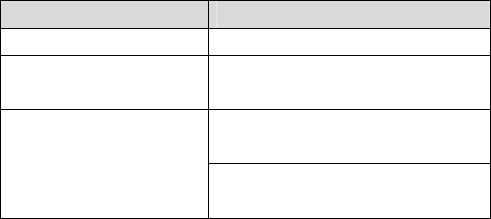
50
FCC Statement of Conformance
This device complies with part 15 of the FCC Rules. Operation is subject to the following two conditions:
(1) This device may not cause harmful interference, and
(2) This device must accept any interference received, including interference that may cause undesired operation.
IC Information
This device complies with Industry Canada license-exempt RSS standard(s). Operation is subject to the following two
conditions:
(1) This device may not cause interference, and
(2) This device must accept any interference, including interference that may cause undesired operation of the device.
Cet appareil est conforme avec Industrie Canada RSS standard exempts de licence(s), Son utilisation est soumise à Les deux
conditions suivantes:
(1) cet appareil ne peut pas provoquer d’interférences et
(2) cet appareil doit accepter Toute interférence, y compris les interférences qui peuvent causer un mauvais fonctionnement
du dispositif.
Tests for EMC and RF including wireless EMC were performed according to the standards in the following table below.
Item Standards
EMC
IEC 60601-1-2
Wireless EMC
EN 301 489-1
EN 301 489-17
RF
47 CFR Part 15C
47 CFR Part 15E
EN 300 328
EN 301 893
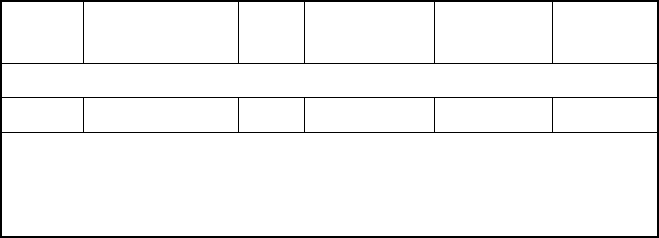
51
EMC
Declaration
1. Compliance Statement
This equipment complies with IEC 60601-1-2 EMC standards for medical devices.
This equipment needs special precautions regarding EMC and needs to be installed and put into service according to the
EMC information provided in the user manual.
Do not use any wireless devices, including cellular phones, near the system. All wireless devices, whether they comply with
the EMC standard or not, may emit electromagnetic interferences and cause the system to malfunction when they are used
nearby.
This equipment should not be used adjacent to or stacked with other equipment; if adjacent or stacked use is necessary,
the equipment should be tested and verified in order to ensure normal operations in the configuration in which it will be
used.
Any changes or modifications not expressly approved by the party responsible for compliance could void the user's authority
to operate the equipment.
All interconnect cables to peripheral devices must be shielded and properly grounded, except when technologically
prohibited. Use of cables not properly shielded and grounded may result in the equipment causing radio frequency
interference.
EMC Cable List
Port
No. Name Type*
Cable
Max. > 3 m
Cable
Shielded Comments
Signal
1 Tether cable I/O 7.0 Shielded None
*Note: I/O = Signal Input or Output Port (Not Involved in Process Control)
The use of cables or accessories other than those specified may result in increased emissions or decreased immunity.
Should any interference (EMC) be detected with other equipment, please position other equipment away from this one.
When using this system on a patient with an implantable pacemaker or an implantable cardioverter defibrillator, the
patient must be informed that continuous X-ray exposure in pulse form may cause the pacemaker or cardioverter
defibrillator to malfunction.
When using this system, ensure that X-rays are not exposed directly onto the patient’s implantable pacemaker or
implantable cardioverter defibrillator, and that the exposure time is kept as short as possible.
This equipment may be interfered with by other equipment, even if that other equipment complies with CISPR EMISSION
requirements.
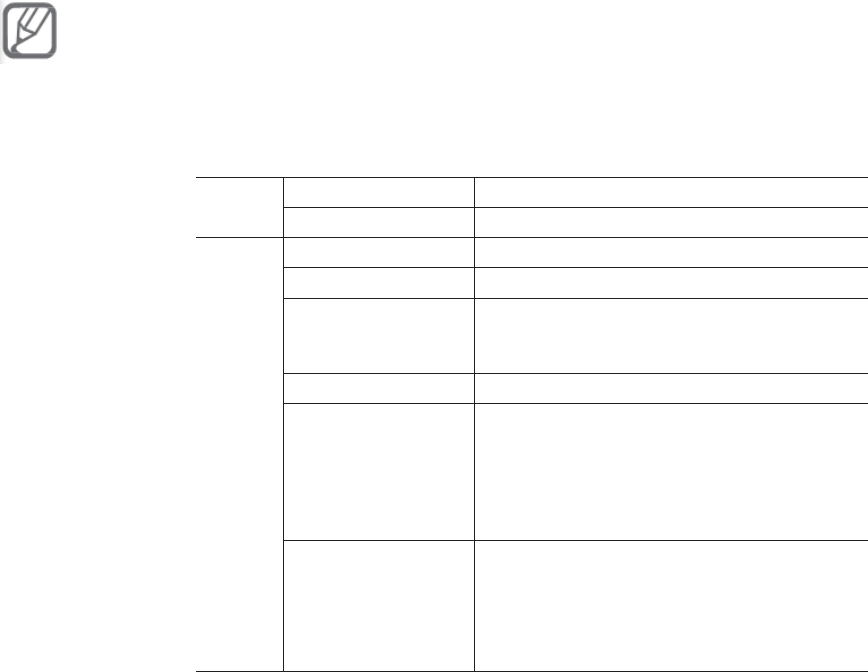
52
This device contains wireless module.
“FCC ID : A3LWIDT30Q”
Restriction
of use
of Wi-Fi using
5
GHz bands(5150
-
5350 MHz)
“In the EU,
the Wi-Fi function
in this
equipment should
not be
used
outdoors.
≑
Wired
&
Wireless
Interface
Wired
Standard
IEEE 802.3
compliant
Physical data
rate
10/100/1000
BASE-T
Wireless
Standard
IEEE 802.11 a/b/g/n
WI-FI
Frequency
2.4GHz/5GHz
dual
Modulation
OFDM with BPSK, QPSK,
16
QAM,
64
QAM,
DBPSK,
CCK
Security
Open, WEP, WPA/WPA2 PSK, PWA/WPA2
Enterprise
Physical data
rate
•IEEE 802.11a
: 6-54Mbps
•IEEE 802.11b
: 1-11Mbps
•IEEE 802.11g
: 6-54Mbps
•IEEE 802.11n
: 6.5-300Mbps
Power Output
(EIRP)
For 2.4
GHz band
:
13.80
dBm
For 5
GHz Lower sub-band
:
14.76
dBm
For 5
GHz Higher sub-band
:
12.39
dBm
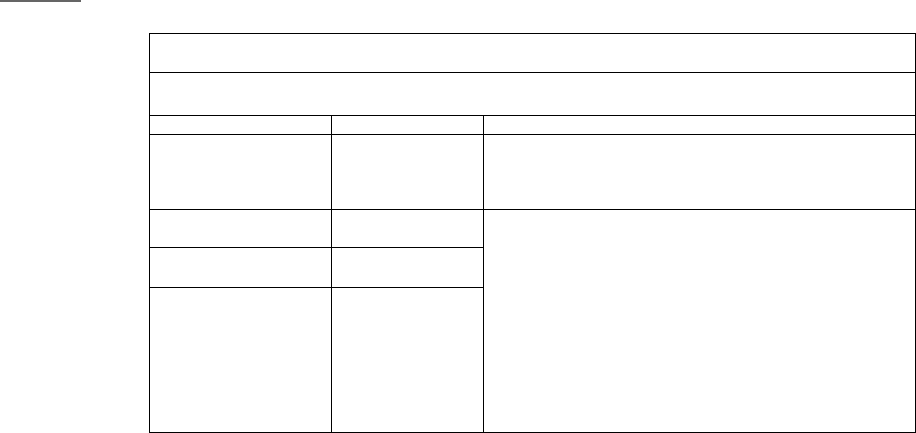
53
Table1
Guidance and manufacturer’s declaration- Electromagnetic
emissions
This Wireless Detector
is
intended
for
use
in
the electromagnetic
environment
specified below. The
user
of
this
Wireless Detector should assure that
it is used in
such
an environment
Emission
t
est
C
omplian
c
e
E
le
c
t
r
omagnetic
e
n
vi
r
onme
n
t
-
guidan
c
e
RF emissions
CISPR 11
Group
1
This Wireless Detector uses RF energy only for its internal
function. Therefore, its RF emissions are very low and are
not likely to cause any interference in nearby electronic
equipment.
RF emissions
CISPR 11
Class A
This Wireless Detector is suitable for use in all establishments
other than domestic, and may be used in domestic
establishments and those directly connected to the public
low-voltage power supply network that supplies buildings
used for domestic purposes, provided the following warning
is heeded:
Warning: This equipment/system is intended for use by
healthcare professionals only. This equipment/system may
cause radio interference or may disrupt the operation of
nearby equipment. It may be necessary to take mitigation
measures, such as re-orienting or relocating the Wireless
Detector or shielding the location.
Harmonics emission
IEC 61000-3-2
Class A
Voltage fl
uctuations/
flicker emissions
IEC 61000-3-3
Complies
W

54
Table2
Guidance and manufacturer’s declaration- Electromagnetic
immunity
This Wireless Detector is intended for use in the electromagnetic environment specified below. The
customer or the user of this Wireless Detector should assure that it is used in such an environment.
IMMUNITY test IEC 60601 test level Compliance level
Electromagnetic
environment – guidance
Electrostatic
discharge
(ESD)
IEC61000-4-2
±6 kV
Contact
±8 kV
Air
±6 kV
Contact
±8 kV
Air
F
loors
should
be
w
oo
d
,
concrete
or
ceramic tile.
If
floors
are covered
with
synthetic material,
the
relative
humidity should
be
at
least
30 %
Electrical fast
Transient
/
burst
IEC61000-4-4
±2kV
for
power supply
lines
±1kV
for
input/output lines
±2kV
for
power supply
lines
±1kV
for
input/output lines
M
ains
p
ow
er
quali
t
y
should
be that of a
typical
commercial
or hospital
environment.
Surge
IEC61000-4-5
±1 kV
diff
erential
mode
±2 kV
common
mode
±1 kV
diff
erential
mode
±2 kV
common
mode
Mains power quality should
be that of a
typical
commercial
or hospital
environment.
Power frequency
(50/60Hz) Magnetic
fi
eld
IEC61000-4-8
3.0 A/m 3.0 A/m
P
ow
er
f
r
equen
c
y
ma
g
netic
fields
should
be at
levels
characteristic of a
typical
location
in a typical
commercial
or hospital
environment.
Voltage dips,
short
Interruptions and
Voltage variations
on
power supply input lines
IEC61000-4-11
<5%
Uт
(>95% dip
in Uт)
for
0.5cycle
40%
Uт
(60%
dip
in
Uт) for 5
cycle, 6
cycle
70%
Uт
(30%
dip
in
Uт) for 25
cycle, 30
cycle
<5%
Uт
(>95% dip
in Uт )
for 5
sec
<5%
Uт
(>95% dip
in Uт)
for
0.5cycle
40%
Uт
(60%
dip
in
Uт) for 5
cycle, 6
cycle
70%
Uт
(30%
dip
in
Uт) for 25
cycle, 30
cycle
<5%
Uт
(>95% dip
in Uт
) for 5
sec
M
ains
p
ow
er
quali
t
y
should
be
that
of a
typical
commercial
or
hospital
environment.
If the user
of
this Wireless Detector
requires
continued
operation
during
power
mains interruptions,
it is
recommended that
this
Wireless Detector
be
powered from
an
uninterruptible power
supply
or a battery
Note:
Uт is the a.c.
mains voltage prior
to
application
of the
test
level.
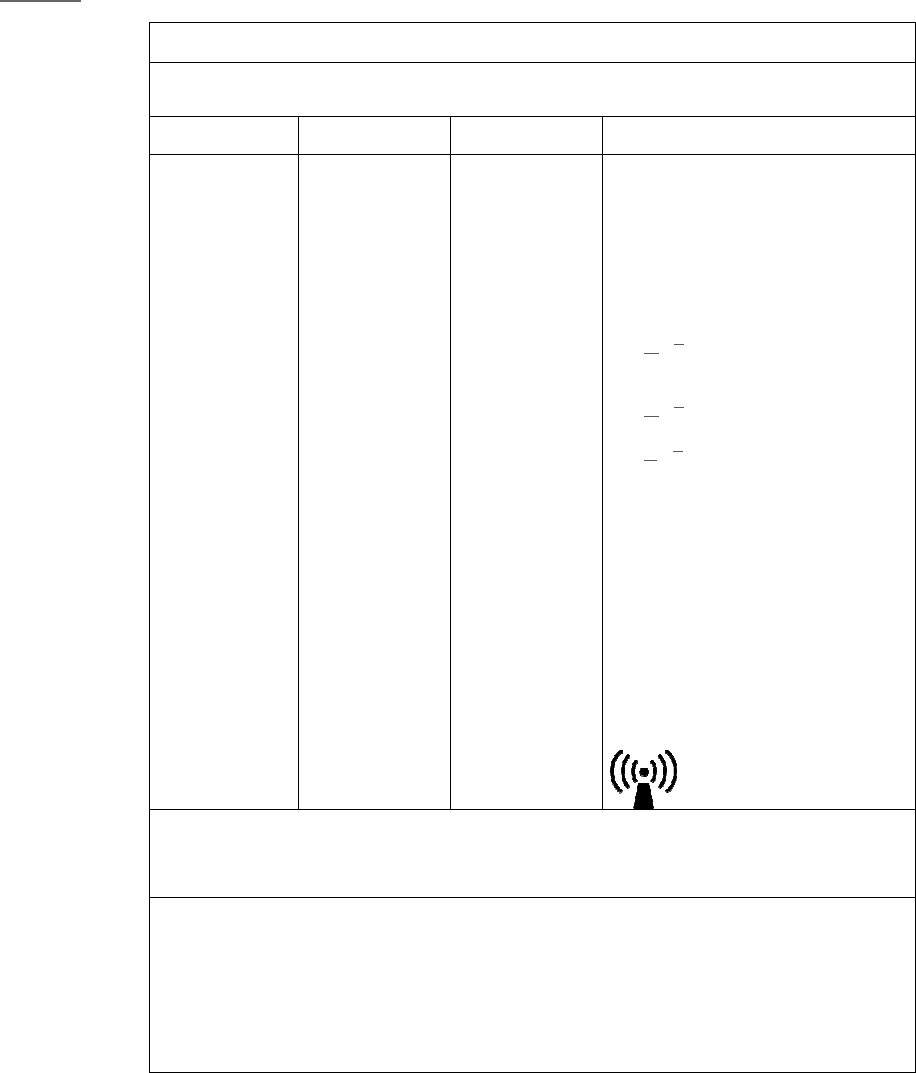
Table3
This Wireless Detector is intended for use in the electromagnetic environment specified
or the user of this Wireless Detector should assure that it is used in such an environment.
IMMUNITY test
Conducted RF
IEC 61000-4-6
Radiated RF
IEC 61000-4-3
NOTE 1 At 80 MHz and 800 MHz, the higher frequency range applies.
NOTE 2
These guidelines may not apply in all situations. Electromagnetic propagation is affected by
absorption and reflection from structures, objects and people.
a
Field strengths from fixed transmitters, such as base stations for radio (cellular/cordless) telephones and land
mobile radios, amateur radio, AM and FM radio broadcast and TV broadcast cannot be predicted theoretically
with accuracy. To assess the electr
site survey should be considered. If the measured field strength in the location in which this Wireless Detector
is used exceeds the applicable RF compliance level above, this Wireless
normal operation. If abnormal performance is observed, additional measures may be necessary, such as re
orienting or relocating this Wireless Detector.
b
Over the frequency range 150 kHz to 80 MHz, field strengths sho
Guidance and manufacturer’s
This Wireless Detector is intended for use in the electromagnetic environment specified
or the user of this Wireless Detector should assure that it is used in such an environment.
IMMUNITY test
IEC 60601 TEST
LEVEL
Compliance
level
3 Vrms
150 kHz to 80 MHz
3 V/m
80 MHz to 2,5 GHz
3 Vrms
150 kHz to 80 MHz
3 V/m
80 MHz to 2,5 GHz
NOTE 1 At 80 MHz and 800 MHz, the higher frequency range applies.
These guidelines may not apply in all situations. Electromagnetic propagation is affected by
absorption and reflection from structures, objects and people.
Field strengths from fixed transmitters, such as base stations for radio (cellular/cordless) telephones and land
mobile radios, amateur radio, AM and FM radio broadcast and TV broadcast cannot be predicted theoretically
with accuracy. To assess the electr
omagnetic environment due to fixed RF transmitters, an electromagnetic
site survey should be considered. If the measured field strength in the location in which this Wireless Detector
is used exceeds the applicable RF compliance level above, this Wireless
normal operation. If abnormal performance is observed, additional measures may be necessary, such as re
orienting or relocating this Wireless Detector.
Over the frequency range 150 kHz to 80 MHz, field strengths sho
55
declaration- Electromagnetic
immunity
This Wireless Detector is intended for use in the electromagnetic environment specified
below. The customer
or the user of this Wireless Detector should assure that it is used in such an environment.
Compliance
level
Electromagnetic environment
150 kHz to 80 MHz
80 MHz to 2,5 GHz
Portable and mobile RF communications
equipment should be used no closer to any
part of this Wireless
Detector, including
cables, than the recommended separation
distance calculated from the equation
applicable to the frequency of the
transmitter.
Recommended separation distance
d
.
√
d
.
√
80 MHz to 800 MHz
d
√
800 MHz to 2,5 GHz
where
P
is the maximum output power
rating of the transmitter in watts (W)
according to the transmitter manufacturer
and
d
is the recommended separation
distance in metres (m).
Field strengths from fixed RF transmitters,
as determined by an electrom
survey,a
should be less than the compliance
level in each frequency range.
Interference may occur in the vicinity of
equipment marked with the following
symbol:
NOTE 1 At 80 MHz and 800 MHz, the higher frequency range applies.
These guidelines may not apply in all situations. Electromagnetic propagation is affected by
absorption and reflection from structures, objects and people.
Field strengths from fixed transmitters, such as base stations for radio (cellular/cordless) telephones and land
mobile radios, amateur radio, AM and FM radio broadcast and TV broadcast cannot be predicted theoretically
omagnetic environment due to fixed RF transmitters, an electromagnetic
site survey should be considered. If the measured field strength in the location in which this Wireless Detector
is used exceeds the applicable RF compliance level above, this Wireless
Detector should be observed to verify
normal operation. If abnormal performance is observed, additional measures may be necessary, such as re
Over the frequency range 150 kHz to 80 MHz, field strengths sho
uld be less than 3 V/m.
immunity
below. The customer
Electromagnetic environment
– guidance
Portable and mobile RF communications
equipment should be used no closer to any
Detector, including
cables, than the recommended separation
distance calculated from the equation
applicable to the frequency of the
Recommended separation distance
is the maximum output power
rating of the transmitter in watts (W)
according to the transmitter manufacturer
is the recommended separation
Field strengths from fixed RF transmitters,
as determined by an electrom
agnetic site
should be less than the compliance
level in each frequency range.
b
Interference may occur in the vicinity of
equipment marked with the following
These guidelines may not apply in all situations. Electromagnetic propagation is affected by
Field strengths from fixed transmitters, such as base stations for radio (cellular/cordless) telephones and land
mobile radios, amateur radio, AM and FM radio broadcast and TV broadcast cannot be predicted theoretically
omagnetic environment due to fixed RF transmitters, an electromagnetic
site survey should be considered. If the measured field strength in the location in which this Wireless Detector
Detector should be observed to verify
normal operation. If abnormal performance is observed, additional measures may be necessary, such as re
-
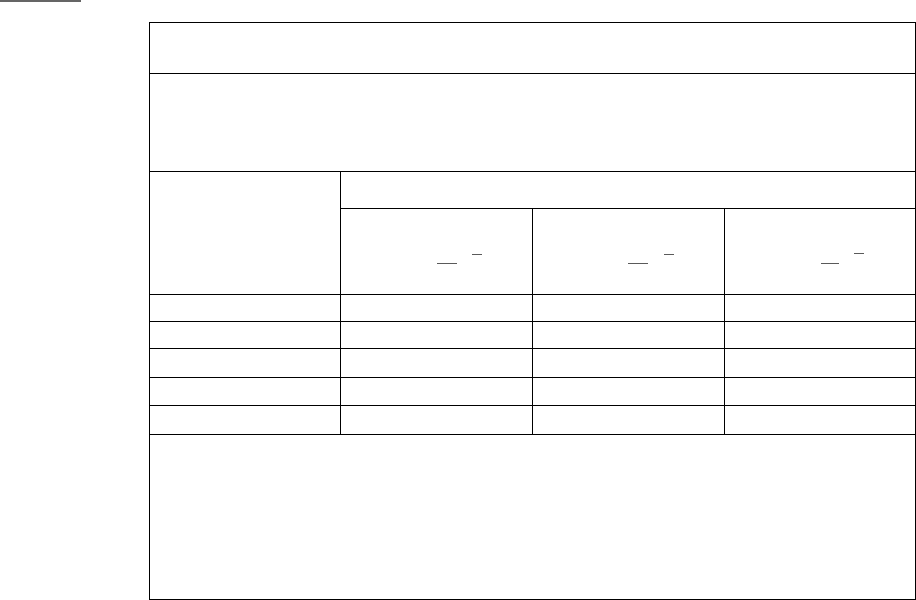
56
Table4
Recommended separation distances between
portable and mobile RF communications equipment and this Wireless Detector
This Wireless Detector is intended for use in an electromagnetic environment in which radiated RF
disturbances are controlled. The customer or the user of this Wireless Detector can help prevent
electromagnetic interference by maintaining a minimum distance between portable and mobile RF
communications equipment (transmitters) and this Wireless Detector as recommended below, according to the
maximum output power of the communications equipment.
Rated maximum output
power
of transmitter
W
Separation distance according to frequency of transmitter
m
150
kHz to
80
MHz
d
3
.
5
1
√
8
0
MH
z
t
o
80
0
MHz
d
3
.
5
1
√
80
0
MH
z
t
o
2.
5
GHz
d
7
1
√
0.01
0.12
0.12
0.24
0.1
0.37
0.37
0.74
1
1.17
1.17
2.34
10
3.69
3.69
7.38
100
11.67
11.67
23.34
For transmitters rated at a maximum output power not listed above, the recommended separation distance
d
in metres (m) can be estimated using the equation applicable to the frequency of the transmitter, where
P
is
the maximum output power rating of the transmitter in watts (W) according to the transmitter manufacturer.
NOTE 1 At 80 MHz and 800 MHz, the separation distance for the higher frequency range applies.
NOTE 2 These guidelines may not apply in all situations. Electromagnetic propagation is affected by
absorption and reflection from structures, objects and people.
57
RF exposure compliance
The available scientific evidence does not show that any health problems are associated with using low power wireless devices. There is no proof, however, that these low
power wireless devices are absolutely safe. Low power wireless devices emit low levels radio frequency energy (RF) in the microwave range while being used. Whereas high
levels of RF can produce health effects (by heating tissue), exposure of low-level RF that does not produce heating effects causes no known adverse health effects. Many
studies of low-level RF exposures have not found any biological effects. Some studies have suggested that some biological effects might occur, but such findings have not
been confirmed by additional research. This device has been tested and found to comply with FCC/IC radiation exposure limits set forth for an uncontrolled equipment and
meets the FCC radio frequency (RF) Exposure Guidelines in Supplement